For more on backcountry creek fishing around Everglades City, see my Florida Sportsman article: FloridaSportsman Backcountry Creek Ways
April 2015
One of the least-visited, but most productive kayak fishing routes in the region is just a stone’s throw from Port of the Island and the Tamiami Trail–but deep in the heart of the Ten Thousand Islands National Wildlife Refuge. I’ve never encountered another angler on this trip, even though I rate it as having the best potential for a big snook or red of any I have sampled hereabouts. It begins inauspiciously in a little road-side lagoon off the Tamiami Trail on what’s marked as Canoe Route #4 by the Ten Thousand Island National Wildlife Refuge folk, then follows a narrow, shallow little creek snaking its way south through a tight corridor of sawgrass into a pristine, hidden wilderness.

In stark contrast to the Port of the Islands and its sister Golden Gates Estates developments to the east, poster children for environmentally rapacious Florida-style real estate projects of the 1970s, this route wanders through a beautiful untouched haven for egrets, spoonbills, ducks, and my favorite Florida bird, the graceful swallow-tailed kite. The channels it follows and shallow ponds it flows through are loaded with mullet and other bait fish, attracting snook and reds that grow fat on the bounty. Tarpon, bass, cichlids, jacks, and snapper also are on the menu for anglers who probe the water carefully.
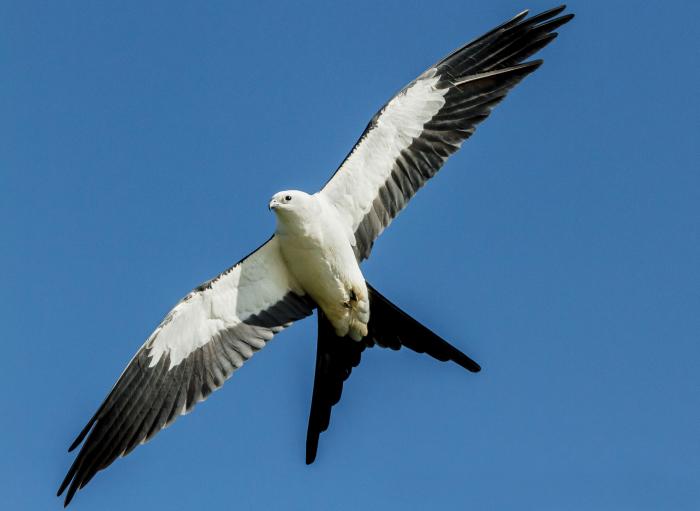
I find the best time to fish CR #4 is in late March and April when fish have sought out the warmer waters of the upcountry and water levels have started to rise as the winter dry season comes to an end, or after a good rain earlier in the year. The going can be tough in the very shallow creek for the first one-half mile, and in November and December, wear orange and make noise—the first series of ponds are favorites among local duck hunters.
To add to the fun, sight and wade fishing are distinct possibilities in the ponds and channels—the snook and reds love to shadow the swirling mullet schools or lay up in the shallows to catch some warm sun rays. I always carry a poling pole and wear wading boots on this trip.
Route Overview
The put-in for this trip is 1.2 miles west of the Port of the Islands Bridge on the Tamiami Trail. There is a wide pull-off and canoe route marker on the south side of the road and a nice little lagoon to launch your boat. Caveat: You may want to avoid this trip if the water level is less than one inch on the depth gauge in the lagoon. You will end up dredging muck for an hour with your paddle or pedals before you reach fishable water. Having said that, don’t ignore the angling potential on either side of the put-in bridge—I’ve caught some good snook and baby tarpon here, with bass and cichlids for good measure.

At the south end of the put-in lagoon, you will see a very narrow cut in the sawgrass that marks a tight, shallow channel that proceeds south for about one-half mile. At the half-mile point, you will see a route marker pole in the distance in front of you to the southeast—DON’T follow it! If you do, you will soon be pulling your boat over a series of mucky sand bars. I know from experience!! Instead, veer directly to the east around a small mangrove island that will lead you into a shallow lake sprinkled with more small mangrove islands. All of this is clearly visible on Google Maps, which you should be able to connect to on your smart phone given the proximity to the Tamiami Trail cell towers. Your destination in approximately one-fifth mile is a channel at the northeast corner of the lake that runs east for about one-half mile before emerging into a series of ponds. Both the shallow lake and the channel can hold good reds and snook, so proceed carefully.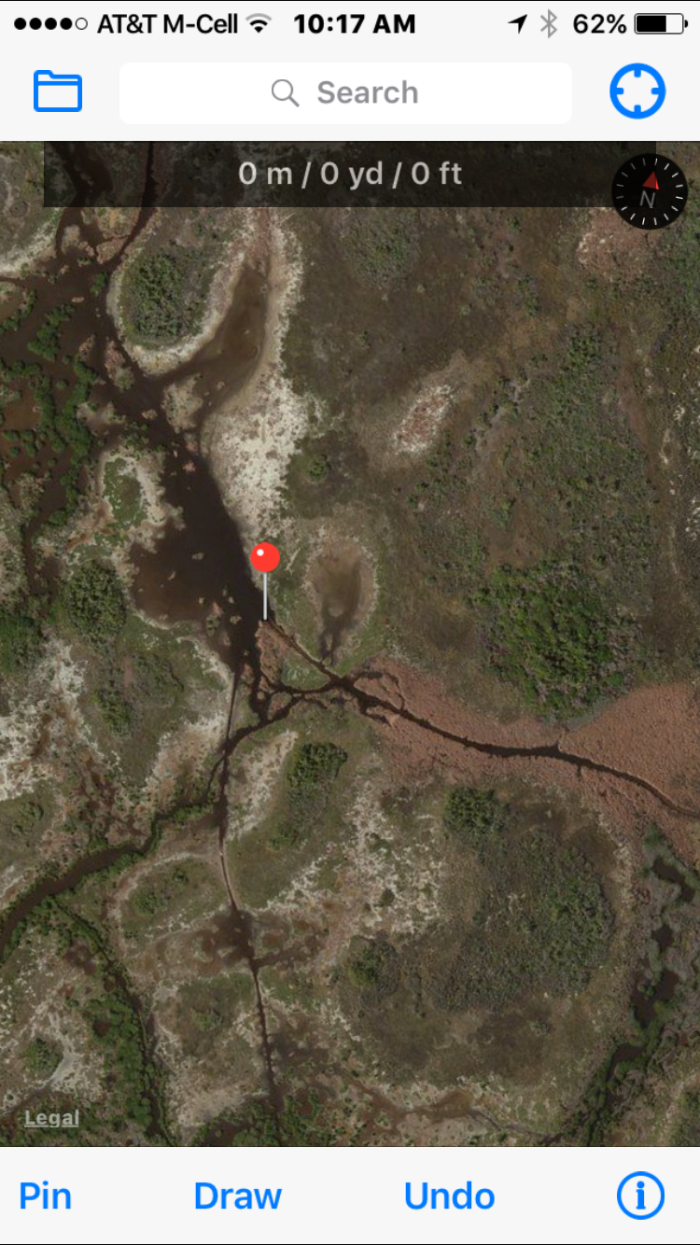
The mouth of the channel, where it connects with a good-sized lake, is covered by a fan-shaped sand bar that will likely require portaging at most water levels, but the sand is firm. I call this Mullet Lake, a tribute to the joyful, jumping mullet that you will see cavorting everywhere! The island to the north can produce some good snook, but the best fishing is to the south through a series of smaller lakes, mangrove islands, and channels. The route wends its way south for about one-third mile to a wide lake then dog-legs to the east in a narrow channel. Take this channel as it heads northeast, then bends back to the southeast to emerge in a very shallow pond that can hold some snook around its islands.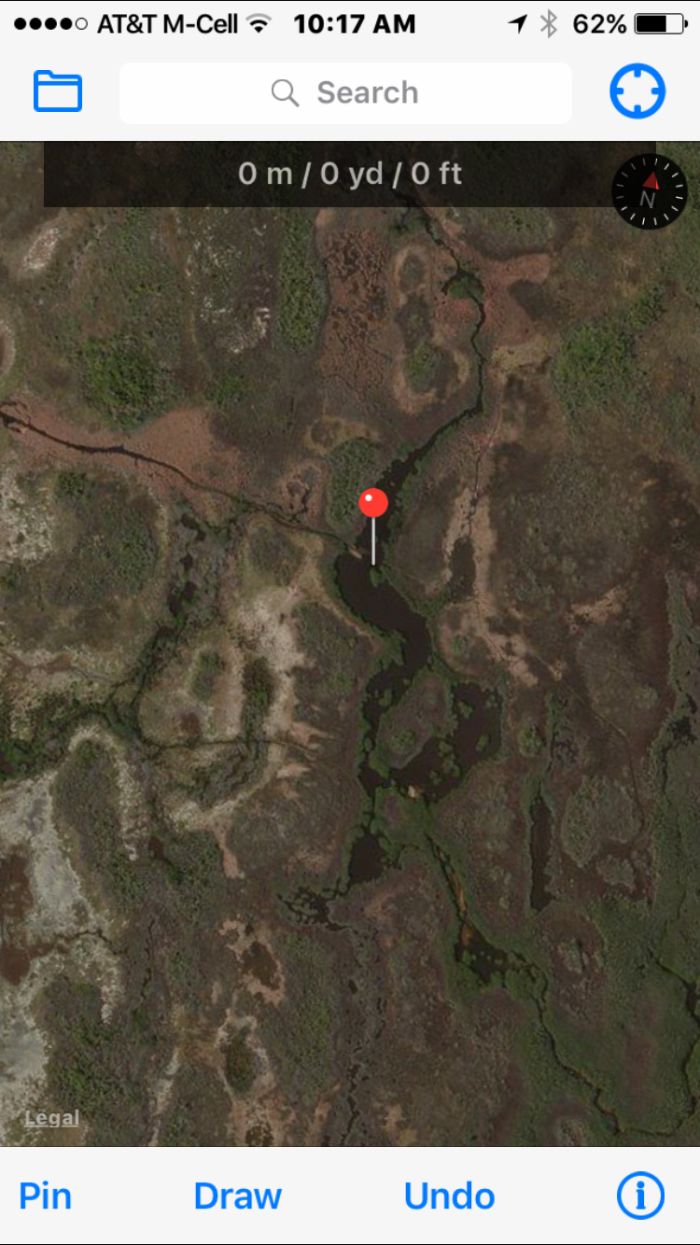
The channel continues with a good flow at the east end of the pond. I usually fish the holes and bends in the channel till it takes a hard turn to the south. Just below this spot, the creek bends hard to the east, creating another deep hole and big sandbar where I often have lunch before retracing my route. The roundtrip is approximately 3.5 miles. It is possible to continue paddling downstream from here about one-third mile to the outlet into the Faka Union Canal on the west side of the Port of the Islands Development. This last leg can be very shallow at low tide and require some dragging of your boat over sand bars, but for the most part the bottom is firm. Once at Port of the Islands, proceed south to the last canal, then east and around to the north to the ramp at the Port of the Islands Marina. This creates a possible loop trip for a two-vehicle outing.
Tackle/Gear/Techique Notes:
The usual upcountry lures will work well here (white curly tail grubs on a jig head, gold spoons, and Zara Spook surface chuggers), but this is one trip where I often carry live shrimp—and big ones work best. I thread the large shrimp twice through the tail on a 2/0 silver bait holder hook or a 1/64 oz weighted, curved fluke hook. This makes a realistic retrieve possible where the shrimp appears to be scooting backwards naturally.
The snook and redfish are often in very shallow water and skittish, so a throwing the shrimp with as little weight as possible to reduce any disturbance is highly advisable. In the put-in lagoon, a popping cork and shrimp (either live or Gulp) is a good bet. In the shallow ponds and channels, a 4-inch new penny fluke mounted weedless has been productive, and with the hook buried in the plastic avoids dredging up moss, grass, and other detritus on the retrieve. In the deeper holes in the channels, a curly tail or live shrimp on a 1/8 ounce jig head is the ticket to get the lure down deep in the hole where the fish like to congregate.

Because of the narrow nature of several of the channels and the overhanging mangroves in the tunnels on this trip, I recommend carrying a single-bladed paddle. When the current is ripping, you will need an anchor to hold your boat in place in the mangrove tunnels while you cast into deep holes. A mushroom anchor is preferable over a fluke style in the mangrove tunnels, where mangrove roots will grab the flukes without fail and not let go!
Because the ponds and sawgrass channels tend to be very shallow, stealth is often the ticket on this trip. Wading quietly in the shallow ponds and channels rather than paddling can be a major advantage. The channels usually have firm bottoms due to the tidal flow; however, the ponds tend to have a lot of muck, so a useful approach is to find a good vantage point stand with firm footing, then wait quietly as the schools of mullet circle about. Snook and reds often swim with these schools, feeding on crabs and other critters the mullet stir up. When wading the mangrove tunnels, look for deeper holes or in indentations along the sawgrass channels where snook like to station themselves, ambushing baitfish that pass by. Wading in the mangrove tunnels also makes accurate casting much easier.
Trip Notes (April)
I’m on the water at first light, and as I push off hear some snook smashing bait under the bridge. I’ve already rigged up a small popping cork and live shrimp mounted on a jig head and pitch it sidearm under the middle span. I pop it once, and a snook blasts off with a meal in his mouth. A frisky 20-incher soon comes to the boat, sans shrimp. I see some more activity on the other side of the bridge where I’ve had good luck in the past, but the water level is above 1-inch on the gauge, so I have to hunch low to peddle underneath, doing my best to avoid the mud dauber nests and spider webs. Emerging, I work the shoreline to the east with a white curlytail Gulp mullet, casting as close to the reeds as possible. I see a swirl and toss the lure that direction….and something boils and sucks it in. To my surprise, a decent largemouth explodes on the surface and bores deep. Then it’s a couple of cichlids hiding in a dark hole under some mangroves. As I approach the far end of the lagoon, a baby tarpon surfaces, gulps some air and disappears. Out comes the popping cork again, this time mounted with a Z-Man shrimp…and it immediately gets tagged by the tarpon that rockets into the air in a series of three jumps before I decide to have mercy and execute a long-distance release. Good start, but time to head for the wilds!
As I pedal south, the sawgrass tunnel narrows and get shallower. When my pedals start to drag in the muck, I pull out the single-bladed paddle and keep on trucking. The double-bladed paddle is too big and unwieldy here. Judging by their wakes, I’m pushing a couple of good-sized fish in front of me—probably alligator gar, but could be reds. Here and there I startle spoonbills and herons.
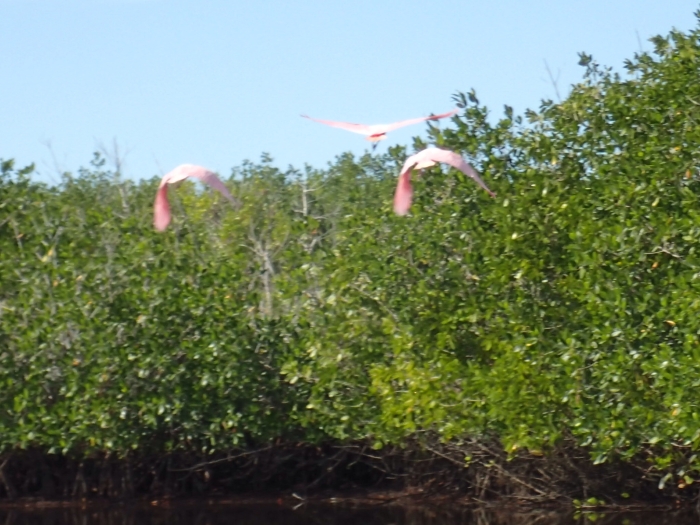
The noise of the highway fades. My first way point, a prominent hammock to the east, is salted with a flock of big white egrets. Soon the tunnel widens, and I’m at the next way point, a small mangrove island that is the signal to turn east. The lake I float into is wide and very shallow, and I can see mullet dancing everywhere. But I know to proceed carefully, because some of those big wakes are not just big mullet, they are sizable snook and reds. It’s possible to pole and sight fish here, but in the past I’ve ended up spooking my quarry. A better strategy is to sit quietly near one of the islands and let the fish come to you. I spot a couple of cruising two-foot reds, but they show no interest in my curly tail or live shrimp threaded on a light-wire bait hook.
I continue to the east, aiming for a narrow channel at the far end of the lake that has a good tidal flow and a hard bottom suitable for wading. I paddle down the channel for a bit, then dismount when I see something swirling in an indentation in the shoreline. I clip the kayak tow rope too my britches and wade carefully within casting distance, then throw a white curlytail mullet towards the ripples. No sooner does the lure hit the water than a big snook nails it. He takes off downstream with me and the kayak in hot pursuit. Finally I turn the critter and he comes in—a solid 26-inch fish! I mount back up in the kayak and continue downstream until I hit a wide, shallow spot in the channel where I clumsily float right into a school of sizeable snook that jet off in all directions. I make a note to tip-toe to this spot when I return upstream in the afternoon.
Then I’m back into a short mangrove tunnel where I see some more snook and spook a school of small reds at the mouth to the shallow lake where I will turn south. I have to pull the kayak over the big sandbar at the mouth, and as I do, I see mullet jumping everywhere and then something big blasting bait around the island just to the north.
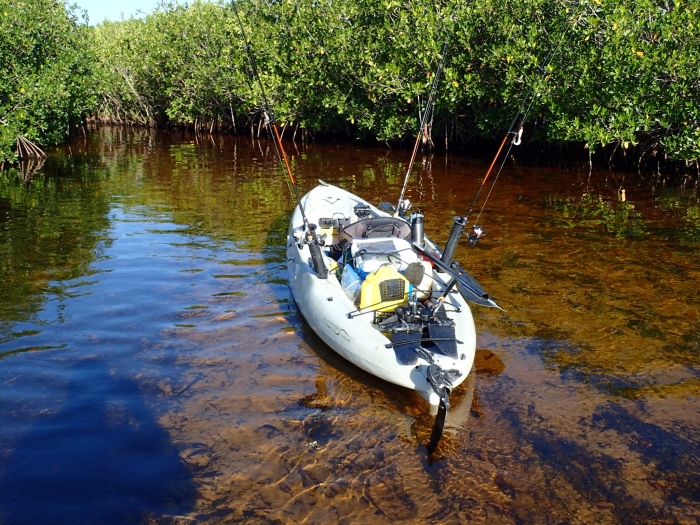
I’m ready for a little surface action fun, so tie on the venerable Zara Spook, a walk-the-dog plug that snook adore. On the third cast on the east side of the island, an eager snook sucks in the lure and the contest is on. He’s a decent twenty-incher, full of fight. After releasing him, I turn south, working the shoreline where I continue to see snook smacking bait. I get a bunch of strikes, but they are mostly bumps and not big blasts, so I don’t get any hook-ups. Next time I’ll bring a tinier version, the Zara Puppy, and see if that makes any difference.
I switch to a new-penny fluke on a weedless hook, and continue casting as the lake dog-legs around a big bend to the right. I fool a couple of baby snook up against a big island, then float through a narrow channel into the next little lake. Here I dismount again, knowing from previous trips snook and red will likely be shadowing the schools of mullet that churn up this very shallow, soft-bottomed pond or will be sunning up against the shoreline. Stealth is the key. I position myself at the edge of the sandbar at the north end and wait. Two schools of big mullet—about 15 fish in each—circle around me nonchalantly. The water is a milky brown, but I spot a silhouette on the far edge of one of the schools….too big and dark to be a mullet. I pitch the new penny fluke ten feet in front of the shadow, and it rushes forward. I feel the line tighten and set the hook. It’s a good red who tears around the pond, scattering the mullet and creating general mayhem. I winch him away from the mangroves and after a good tussle, he relents. Almost 30-inches!!

I move on to the next lake, a very shallow one to the east where I see several nice snook sunning themselves who refuse to eat, then retrace my route to the lake where I caught the red, and south through a deeper lake–but come up empty. My GPS guides me to the main channel that shoots off to the east. The correct route is obvious from the extensive sandbars created by tidal flow that show up as light-colored swirls in the channel downstream. If you continue south you will end up in a series of small lakes with little current, which usually means fewer fish.
The channel narrows into a mangrove tunnel that is a favorite spot for snook, but where casting is in tight quarters. This is where a short six-foot rod comes in handy and the ability to use a back-hand cast, drawing the rod across the body instead of to the side or overhead, then flipping the lure into likely looking deeper spots under the mangroves. I spot a nice-sized snook fining in the current no more than 20 feet in front of me, but fortunately the current is coming in, so he’s facing into it, away from me. I arc my cast over his head, and the white curlytail lands 15 feet in front of the fish, then sinks out of sight. I jig it once, and the snook blasts it then starts his dance around the mangrove tunnel, first to one side and then the other. He’s into the mangrove roots, but I haul him out—this is why I use a 30# leader so the fish can’t saw me off. I’m shaking when the snook finally comes to the boat, a respectable twenty-four inches!! The tunnel soon opens into a wide spot where another creek enters from the north (it’s actually just a channel to the very shallow lake to the north I had fished without any luck earlier). There’s a nice hole at the confluence, and I get a strike, but the snook wriggles off.
The same scene is repeated a couple of more times as I pedal slow down the channel, the snook managing to win those battles as well. I do land a couple of hungry little snapper that manage to tear up the curlytail with their sharp teeth. I emerge into the last shallow lake in the chain, and hook but lose a baby snook around a trio of islands in the middle. I continue to probe the deep holes in the mangrove tunnel and channel below, but without any luck until I hit the big S bend where the creek has carved out two deep holes. With the tide still coming In, I anchor up at the west end of the first bend just before the creek turns south and pitch the curlytail downstream to the bottom of the pool. The lure immediately sinks out of sight, and I watch as the incoming current pushes the line back towards me. Then a feel a little bump and set the hook. It’s a small red, but he’s a good fighter. I release him and cast again…same reaction, but this time I miss the bite. Then again. The fish are flashing at the lure as I bring it closer to the boat, but seem skittish. Time for Plan B—a live shrimp on the jig head, threaded twice through the tail. The first cast is slammed by a twenty-inch snook, as is the next and the next. It’s great fun for a half hour—I land six more small snook, another bigger red, and several snapper. Talk about a honey hole.
Finally I head downstream to the next bend, where I anchor up on a sandbar and work the deep hole there. I manage a baby snook, then latch onto something big. I’m thinking big red, but alas it’s a big catfish. Good fight, but no cigar. My thoughts turn to lunch, but in my haste to get the cat off my hook, I carelessly let the whirling dervish (they love to spin on the end of the line) spike me in the palm with his dorsal fin’s sharp point. Damn that hurts, and soon I’m feeling a little dizzy and nauseous. I will find out later that the fins of saltwater cats have toxins that can definitely make you sick. I sit down and think I may have to call for help, but within 15 minutes the wooziness subsides. Lucky me. Supposedly pouring hot water on the wound is good treatment, breaking down the toxins, but I hope not to have to experiment in the future.
After lunch, I head back upstream. The tide has started to turn, so I anchor up at the bottom of the honey hole on the return trip and pitch my lure upstream and let it drift down deep and back to me. I nail a couple more snook, and another red, all on the curlytail. Nothing hits the shrimp. Go figure!?! Then it’s back towards the fork upstream where I want to try that little hole at the confluence.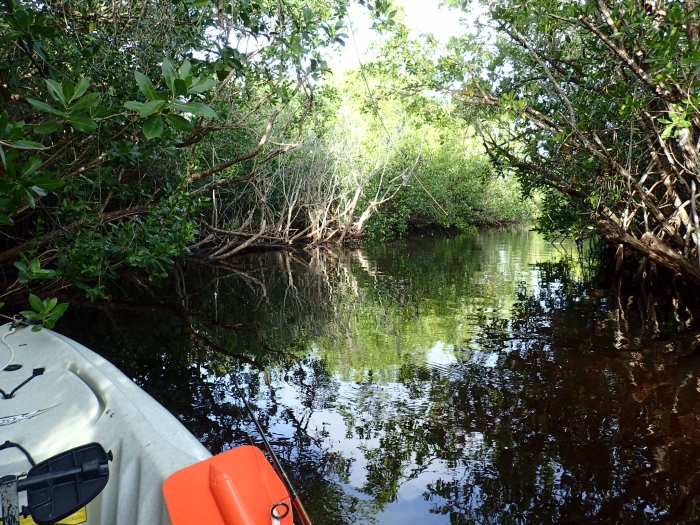
The current is ripping out fairly well now and makes holding the kayak in position somewhat difficult, so I dismount, anchor it, and approach the confluence hole very carefully. I throw a curve cast up under the mangrove tunnel to west and let the lure wash into the hole. My mouth drops when a three-foot snook erupts with the curlytail in her mouth, shaking her head like an angry dog while she tail walks across the surface. Just as I begin to think of what a trophy photo this will make, the lure comes flying back my way, and the snook rockets up the other channel, pushing a big wake, and long gone. What a beauty that big girl was, one of the biggest I have hooked here in the upcountry.
Wading, I follow the girl’s route up the channel, and startle a couple of smaller snook that disappear before I can get a cast off. As the channel opens into the shallow lake to the north, I scare a couple of bigger snook lying below a big sandbar that requires me to drag the kayak over it. As I wend my way back west and north through the chain of shallow lakes, I am surprised not to see any snook hitting the surface like they were this morning. Indeed, I don’t spot any fish or have any strikes until I am half way back up the main channel heading west. Now I remember to jump out of the kayak, anchor it, and tread carefully as I approach the wide, shallow spot in the channel upstream. And sure enough, the flotilla of snook I spooked this morning are back and finning over a big sandbar. They are good ones—twenty-four inches plus—and facing upstream into the outgoing tide, don’t see me. A jig isn’t going to work here—will make a big splash when it lands and then probably snag up on the grass and detritus on the bottom. I decide to thread a big live shrimp on a large 2/0 silver bait-holder hook and cast it without any weight to reduce the disturbance when it hits the water. The snook are only 30 feet in front of me, so I loft a short cast past and to the side of the school, then jig it slowly, letting it drift back to me. Several snook immediately take up the chase and follow the shrimp as it bumps downstream in the current. No more than ten feet away, a bold one nails it and shoots off like a guided missile upstream with me in hot pursuit. I manage to turn the snook before he can get into the next mangrove tunnel, the wrestle him to the shoreline. He goes 26 inches, a great way to end the day. I smile and think, you can’t ask for much more than you get on good old Canoe Route #4!!



Hi, I’m headed to the Chokoloskee area in mid-January to fish for 3-4 days… would you be available to guide them? Thanks
LikeLike
Thx for the note Bob. I won’t be back down there till late January. Sorry. Hope my articles help you find the fish.
LikeLike